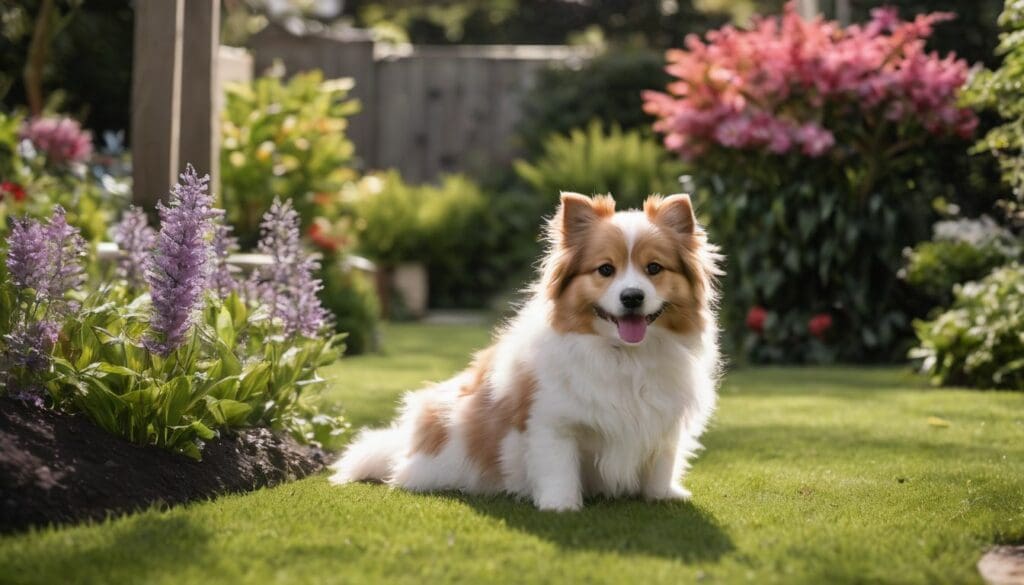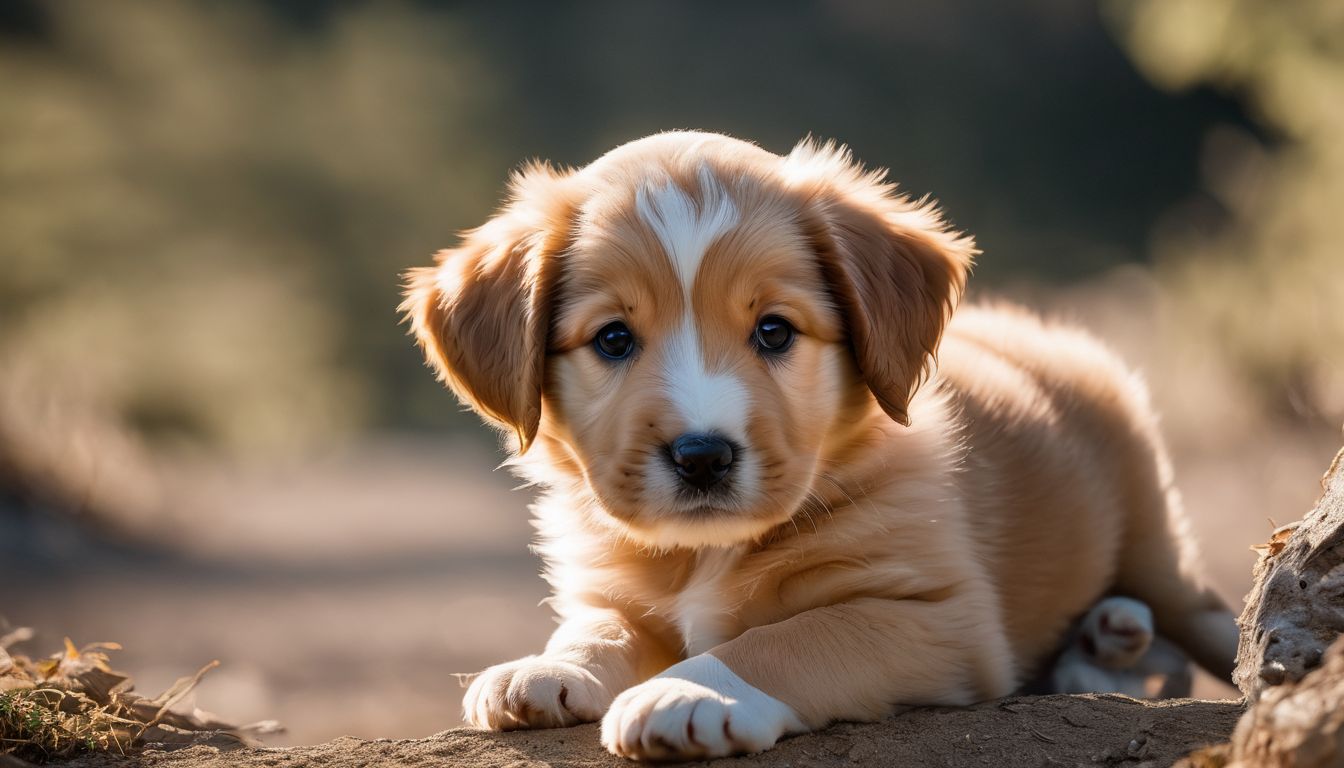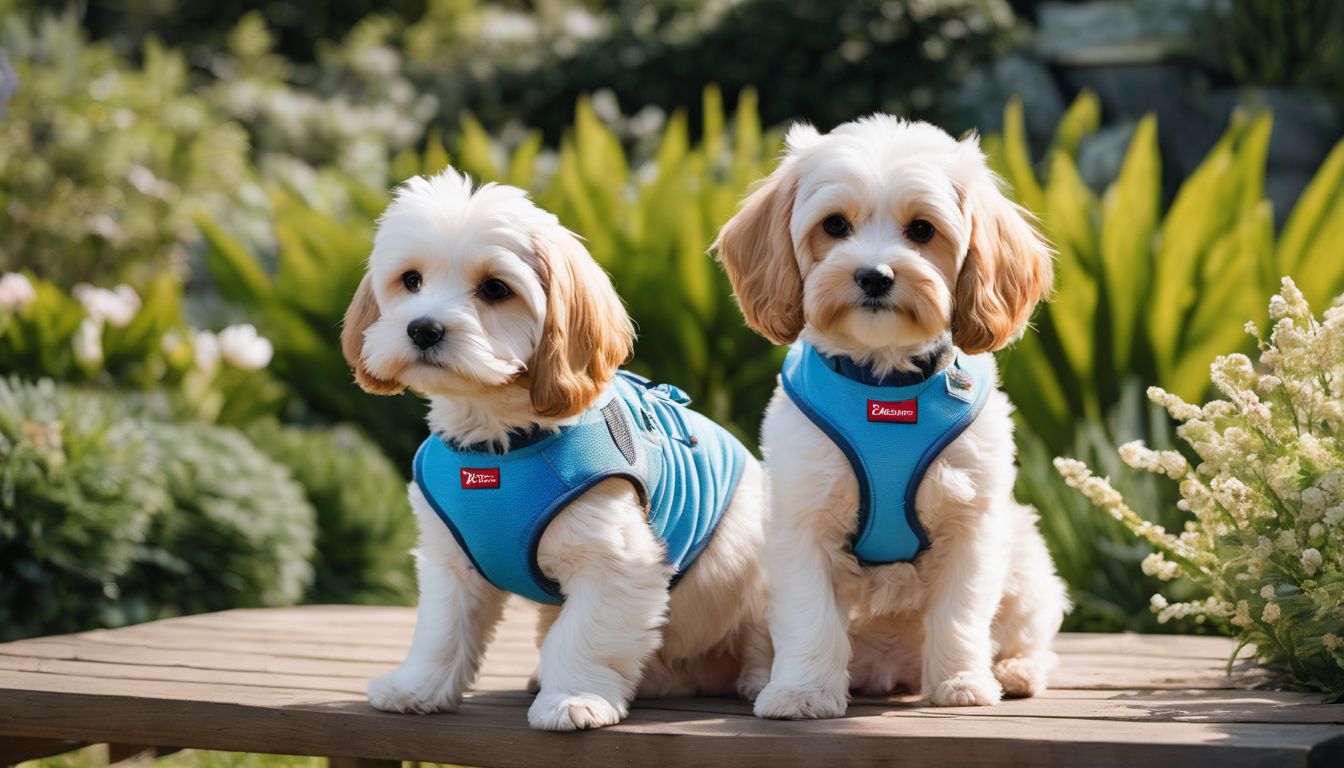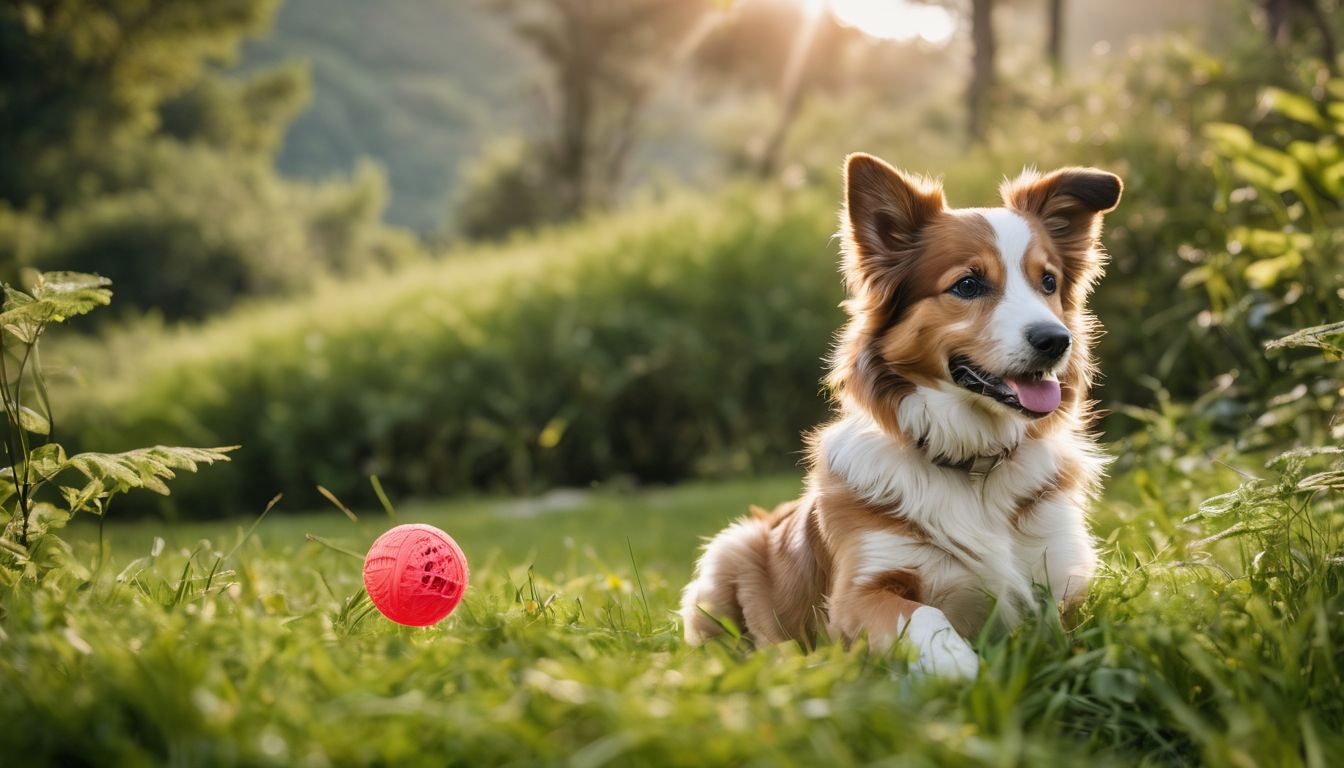Gardening with pets can be a tricky balance, as your furry friends don’t always know which plants are safe. Surprisingly, over 700 plants have been identified as toxic to animals if ingested.
This article guides you through creating a garden where both you and your pets can flourish safely together. Let’s dig in for their sake!
Key Takeaways
- Install durable fences and gates tall enough to prevent pets from jumping over, providing a secure garden space whilst checking for gaps or weak spots regularly.
- Select plants that are safe for pets by avoiding toxic varieties like lilies and azaleas, opting instead for friendly options such as marigolds and sunflowers.
- Use mature plant starters to establish a robust garden quickly, choosing sturdy border plants that can handle pet activity and serve as natural barriers.
- Introduce containers and raised beds to protect delicate plants from being trampled by pets, creating designated spaces separate from pet-accessible areas.
- Implement natural pest control methods in your gardening practices to ensure the health of both your garden and your pets.
Preparing Your Garden for Your Pet
Before creating a pet-friendly garden, it’s important to observe your pet’s habits and routines. Installing sturdy fences and gates can also help keep your pets safe while they explore the outdoors.
Consider replacing part or all of your lawn with more durable surfaces that can withstand playtime with your furry friends.
Observe your pet’s habits and routines
Watch your pet closely to learn where they love to play, rest, and explore in the garden. This knowledge is crucial for creating a pet-friendly outdoor space that caters to their preferences while ensuring their safety.
Notice if your dog enjoys lounging in the sun or if your cat prefers stalking through shaded areas. Use these observations to strategically place pet-safe plants and shelters that will enhance their outdoor experience.
Map out zones in your garden based on these habits. For instance, you might dedicate a sunny corner for basking or a sheltered spot for hiding and resting. Keep track of the paths they naturally take; this helps when planning walkways or barriers in your dog-friendly back garden ideas.
With this insight, move on to fortifying boundaries with sturdy fences and gates, which is essential for their protection and the integrity of your garden design.
Install sturdy fences and gates
To create a pet-friendly garden, install sturdy fences and gates to provide a safe and secure outdoor environment for your pets.
- Choose durable materials such as wood or metal for your fences and gates, ensuring they are tall enough to prevent pets from jumping over them.
- Regularly inspect the integrity of your fences and gates to make sure there are no gaps or weak spots that could compromise the security of your garden.
- Consider using decorative fencing that not only enhances the aesthetics of your garden but also serves as a functional barrier for your pets.
- Install self – closing gates with secure latches to prevent pets from wandering out of the garden unsupervised.
Consider replacing part or all of your lawn
Replace part or all of your lawn with pet-friendly landscaping options. Opt for ground cover plants like clover, creeping thyme, or perennial ryegrass that are more durable and require less maintenance than traditional grass.
This will create a safer and more sustainable outdoor space for your pets to enjoy.
By choosing low-maintenance alternatives to grass, you can reduce the need for harmful chemical pesticides and excessive watering while still maintaining a beautiful garden environment.
Additionally, this eco-friendly approach supports conservation efforts and promotes a healthier ecosystem for wildlife in your garden.
Choosing Pet-Friendly Plants
When choosing plants for your pet-friendly garden, it’s important to know which plants are toxic and safe for pets. Using mature plant starters and selecting sturdy border plants and barriers will help keep your garden safe for your furry friends.
Knowing which plants are toxic and safe for pets
When creating a pet-friendly garden, it’s crucial to know which plants are toxic and safe for your furry friends. Some common garden plants such as lilies, daffodils, tulips, and azaleas can be harmful to pets if ingested.
On the other hand, pet-safe plants like marigolds, sunflowers, and roses are excellent choices for a vibrant and hazard-free garden that your pets can enjoy. Familiarising yourself with these plant varieties will help you make informed decisions when choosing greenery for your outdoor space.
Selecting the right flora is vital in ensuring the safety of your pets while they roam freely in the garden. By opting for non-toxic vegetation and avoiding harmful species, you can cultivate a lush yet secure environment where your animals can thrive without any health risks from poisonous plants.
Using mature plant starters
When considering pet-friendly plants, using mature plant starters can provide an immediate and robust garden environment for your furry friends. Mature plants are more established, making them sturdier and less appealing to curious pets that may be tempted to dig or chew on tender young growth.
This not only creates a safer environment but also saves time waiting for smaller plants to grow, ensuring your garden is quickly established with hearty greenery that can withstand the rigours of pet play.
Mature plant starters contribute to an instantly lush and vibrant landscape, offering your pets ample opportunities for exploration without disrupting delicate new growth. When selecting mature plant starters, opt for sturdy varieties such as shrubs and trees that provide natural barriers, enhancing both the visual appeal of your garden and the safety of your beloved animals.
Selecting sturdy border plants and barriers
When selecting plants for your garden, choose sturdy border plants and barriers that can withstand the occasional rough play of pets. This will help create a defined and protected area for your pet to stay within.
- Choose robust shrubs and bushes like boxwood, holly, or euonymus to serve as natural barriers around the edges of your garden. These plants are durable and can withstand potential impact from playful pets.
- Install low fences or trellises with climbing plants such as jasmine or clematis to create a physical boundary that is both functional and visually appealing. This adds an extra layer of protection for your garden whilst providing an attractive feature.
- Utilise stone or brick borders along pathways to delineate areas where pets should not dig or roam freely. The solid structure will discourage pets from venturing into specific sections of the garden.
- Incorporate dense groundcover plants like periwinkle or carpet bugleweed along the perimeter to form a living barrier that is both resilient and aesthetic.
Creating a Safe and Accessible Garden Space for Your Pet
Utilise containers and raised beds to prevent pets from trampling on delicate plants, establish a perimeter and designated paths for your pet to explore the garden safely, and use strong smells such as citrus or coffee grounds to deter digging.
Read more about creating a safe outdoor space for your pet in our blog!
Using containers and raised beds
To provide a safe and pet-friendly garden environment, using containers and raised beds is an effective strategy. This creates designated spaces for plants while keeping them separate from areas accessible to pets. Moreover, it allows for a controlled environment where you can manage soil quality and drainage more effectively.
- Containers and raised beds elevate plants off the ground, reducing the risk of trampling or urination by pets.
- They also serve as barriers that prevent pets from accessing specific areas of the garden where certain plants may be sensitive to disturbance.
- Additionally, containers and raised beds offer a versatile solution for growing pet – friendly plants in gardens with limited space or poor soil quality.
Establishing a perimeter and designated paths for your pet
To ensure your pet’s safety and enjoyment in the garden, it’s important to establish a perimeter and designated paths. Here are some ways to achieve this:
- Use natural barriers such as hedges or shrubs to define the edges of your garden space. This not only provides a clear boundary for your pet but also adds greenery to the landscape.
- Create designated paths using materials like gravel, stepping stones, or mulch. These paths can guide your pet to specific areas while preventing trampling on delicate plants.
- Incorporate low fencing or decorative borders to outline areas that should be off-limits to your pet, such as flower beds or vegetable patches. This helps maintain the integrity of the garden while giving your pet clear boundaries.
Using strong smells to deter digging
Use strong-smelling repellents like citrus peels, coffee grounds, or vinegar in areas prone to digging.
Designing for Your Pet’s Needs
Provide shelter and shade for your pet to rest in, include larger plants for play, and use pet-safe gardening practices to ensure a safe and healthy environment for your furry friend.
Providing shelter and shade
Shelter and shade are essential for pets in the garden. Place pet-friendly plants strategically to create shaded areas, and consider adding a freestanding structure or pet house where your furry friend can rest comfortably.
Large plants such as trees or shrubs also offer natural shelter from the sun, providing a cool and safe retreat for your pet within the garden space.
Incorporate elements like gazebos, pergolas, or parasols to create shady spots where your pets can relax without direct exposure to the sunlight. Pet-safe materials should be used for any shelters or structures that you add to ensure a safe environment for your furry companions.
Including larger plants for play
Choosing larger, sturdy plants for play areas in your pet-friendly garden is essential. These plants can provide shade, shelter, and a sense of adventure for your pets while also adding beauty to your outdoor space.
Be sure to select non-toxic varieties that are safe for your pets to interact with and explore. Incorporating robust foliage will create an engaging environment where your furry friends can roam freely without causing damage.
As you plan which larger plants to include in the play area, consider how they will enhance the overall design of the garden. Select options that add texture, height, and interest to create an enriched environment for both you and your pets.
Using pet-safe gardening practices
Opt for natural pest control methods such as companion planting and introducing beneficial insects to keep your garden free from harmful pests, without endangering your pets. Implement organic fertilisers and compost in your gardening routine instead of chemical-based products.
Opt for non-toxic solutions to protect your plants, avoiding harm to your beloved pets.
Utilise raised beds and containers technique, reducing the risk of soil contamination by toxic chemicals or fertilisers that could be harmful to pets like dogs or cats. Incorporate mulch made from pet-safe materials that is free from harmful toxins or chemicals like cocoa mulch which can be toxic if ingested by pets – opting for materials that pose no threat to their health while they play freely in the garden space.
Conclusion
In summary, creating a pet-friendly garden involves observing your pet’s habits and installing sturdy fences. Choosing pet-safe plants, using containers and raised beds, and providing shelter are essential steps.
Designing for your pet’s needs by including larger plants for play is also crucial. Ultimately, prioritising safety and accessibility will result in a thriving outdoor space that both you and your furry friend can enjoy.
FAQs
1. What are the first steps to create a pet-friendly garden?
Start by planning a pet-friendly garden with petsafe plants and landscaping that gives your furry friends room to play without hazards.
2. Can I have a stylish outdoor space that is also safe for my dog?
Certainly! You can design a dog-friendly backyard with beautiful, safe plants and garden ideas that keep both style and your pet’s safety in mind.
3. How do I choose plants for my cat-safe garden?
Choose cat-safe garden plants carefully; make sure they’re non-toxic to felines and plan an outdoor space where your pets can safely explore.
4. Are there special tips for building a dog-friendly landscape?
Yes, use these pet-friendly landscaping tips: include shaded areas, avoid harmful chemicals, and provide plenty of water sources in your dog-friendly landscaping ideas.
5. What should I consider when creating an animal-friendly outdoor environment?
When building a pet-friendly outdoor environment, ensure it’s secure from escape points, contains no poisonous substances or sharp objects, and includes fun zones for play.
6. Is it possible to maintain an attractive garden while making it accessible to pets?
Absolutely! With creative planning and implementing pet-friendly backyard design elements like pathways and durable grasses you can have an appealing yet functional yard for everyone.





